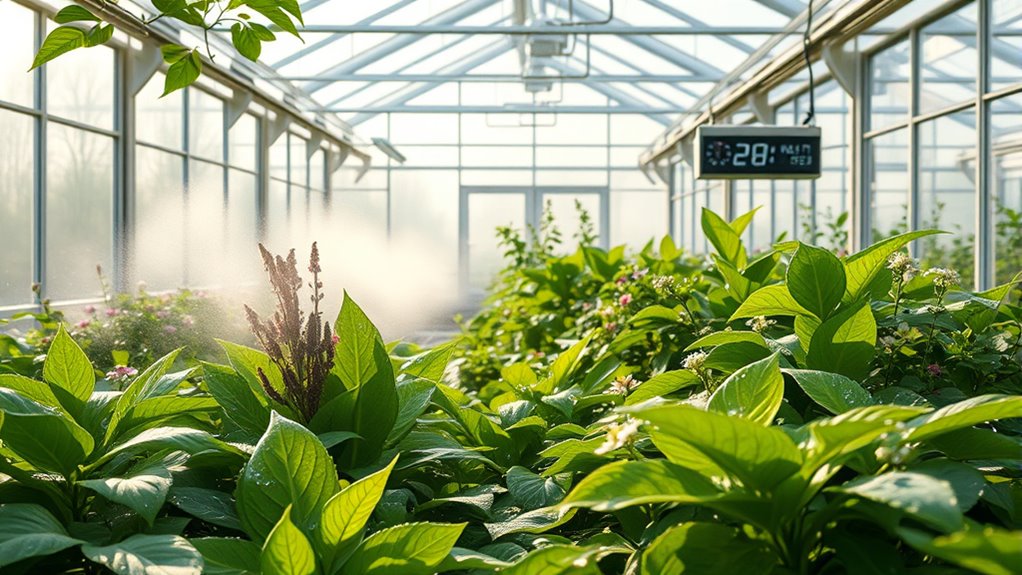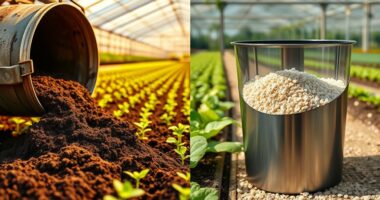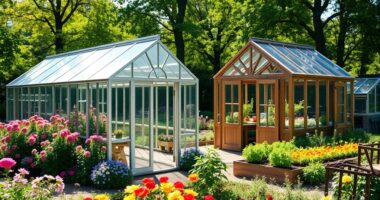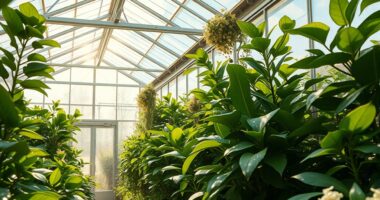To keep your greenhouse balanced, monitor humidity levels regularly with a hygrometer and adjust using evaporative cooling when conditions are dry or dehumidifiers when it’s too humid. Combining ventilation and moisture control methods helps you create an ideal environment for healthy plants. Maintaining proper humidity prevents issues like mold, root rot, and stress. Stay proactive, and you’ll create a thriving greenhouse atmosphere—more tips on mastering this balance lie ahead.
Key Takeaways
- Monitor humidity levels regularly with hygrometers to maintain optimal conditions for plant health.
- Use evaporative cooling to increase humidity in dry environments and prevent stress on plants.
- Implement dehumidifiers and ventilation to reduce excess moisture and avoid mold or root rot.
- Balance heating, cooling, and moisture control methods to create a stable, healthy greenhouse environment.
- Adjust humidity strategies based on real-time data to ensure consistent, ideal conditions for plant growth.
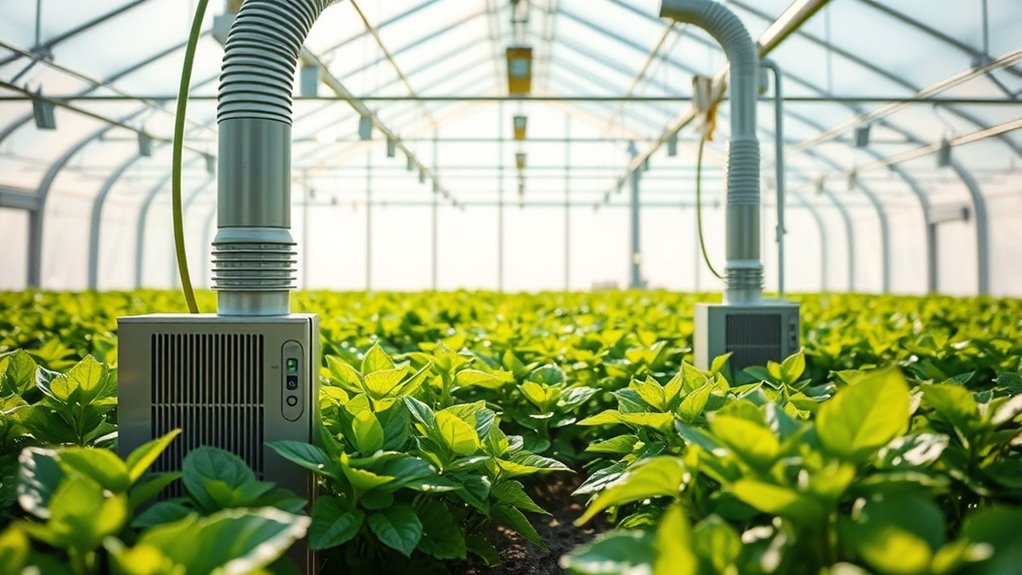
Maintaining proper humidity levels is essential for preserving your home’s comfort and preventing damage. Whether you’re managing a greenhouse or simply aiming for a more comfortable living environment, understanding how to control humidity is key. One effective way to regulate moisture levels is through evaporative cooling, which not only cools the air but also reduces humidity in dry conditions. This method works by adding moisture to dry air, but in humid environments, it’s important to balance evaporative cooling with dehumidification techniques. These techniques include using dehumidifiers, ventilation, and air conditioning systems designed to extract excess moisture. When humidity gets too high, mold growth, musty odors, and structural damage can occur, so keeping it in check is crucial for the health of your home and its contents.
In a greenhouse setting, controlling humidity becomes even more critical because plants thrive within specific moisture ranges. Evaporative cooling can be a natural solution during hot, dry days, helping to maintain a stable environment for your plants. However, if the air becomes too humid, you’ll need to implement dehumidification techniques to prevent issues like fungal diseases or root rot. Modern dehumidifiers are highly effective at pulling excess moisture from the air, allowing you to fine-tune the humidity to ideal levels. Ventilation also plays a significant role; by increasing airflow, you can remove moist air and bring in drier, fresh air from outside. This helps prevent humidity from building up excessively inside your greenhouse.
Another important aspect is monitoring humidity levels continuously. Using a hygrometer, you can track moisture content in real-time and make adjustments accordingly. When the air is too dry, evaporative cooling can help add some moisture back, especially if your plants need higher humidity. Conversely, when the air gets too moist, running a dehumidifier or increasing ventilation can bring things back into balance. Combining these methods allows you to create a controlled environment that supports healthy plant growth and minimizes risks associated with improper humidity levels. Proper humidity management is essential in maintaining a balanced environment for both your home and your plants.
Frequently Asked Questions
How Does External Weather Impact Greenhouse Humidity Levels?
External weather considerably impacts your greenhouse humidity levels. When it’s hot and dry outside, you may need to increase ventilation strategies to prevent excess dryness. Conversely, during humid or rainy days, microclimate adjustments like dehumidifiers or opening vents help manage moisture buildup. Monitoring external conditions enables you to adapt your ventilation strategies promptly, maintaining a balanced environment that promotes healthy plant growth inside your greenhouse.
Can Specific Plants Tolerate Higher or Lower Humidity?
Yes, you can select plants based on their humidity tolerance, as some thrive in high humidity while others prefer drier conditions. To help your plants adapt, use humidity adaptation strategies like misting, humidity trays, or ventilation adjustments. By understanding each plant’s humidity tolerance, you can create a balanced environment, ensuring healthy growth and preventing stress or disease caused by unsuitable humidity levels.
What Are the Signs of Improper Humidity in a Greenhouse?
You’ll notice signs of improper humidity when plants show wilting, leaf edges turn brown, or mold and fungal growth appear. Use humidity sensors regularly to monitor levels and adjust your misting systems accordingly. Too high humidity causes condensation and disease, while too low leads to dryness and stress. Keep an eye on these signs and sensor readings to maintain a healthy, balanced environment for your plants.
How Often Should Humidity Levels Be Checked?
Think of checking your greenhouse humidity like tuning a musical instrument; regular adjustments keep everything in harmony. You should check humidity levels at least twice daily using reliable humidity sensors, and don’t forget to calibrate your gauges monthly for accuracy. Keeping a consistent schedule guarantees your plants thrive, preventing issues like mold or dehydration. Regular checks help you respond quickly to changes, maintaining the perfect environment for your greenhouse’s success.
Are There Eco-Friendly Methods to Regulate Humidity?
Yes, you can use eco-friendly methods like natural dehumidifiers and organic humidity control. For instance, placing charcoal or silica gel can absorb excess moisture without chemicals, and using plants that naturally regulate humidity helps maintain balance. Ventilation through open windows or vents also promotes airflow, reducing humidity naturally. These methods are sustainable, cost-effective, and safe for your greenhouse environment while effectively controlling humidity levels.
Conclusion
So, after all this talk about humidity, you’d think it’s simple to keep your greenhouse perfectly balanced. But here’s the irony: the more you try to control every percentage point, the more unpredictable nature becomes. Sometimes, the best way to succeed is to accept a little chaos—after all, a little humidity fluctuation might just be what your plants need to thrive. Embrace the unpredictability, and enjoy the dance of humidity in your greenhouse.
